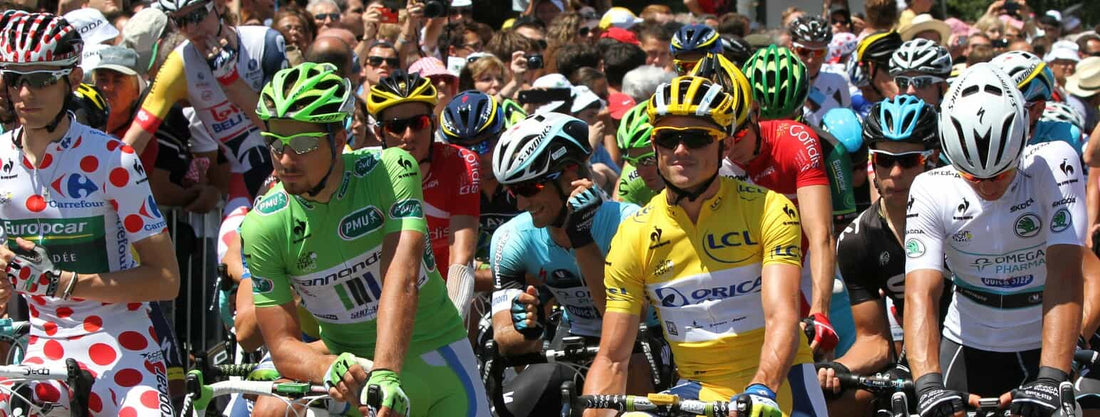
From Yellow to Polka Dots: Understanding the Significance of Tour de France Jerseys
Share
The Significance of Jerseys in Tour de France
The jerseys in the Tour de France are not just pieces of fabric; they hold immense significance and carry a rich history. They represent the values and traditions of the race, as well as the dedication, skill, and determination of the riders who wear them.
These jerseys create a sense of identity for the riders and their teams. They serve as a visual representation of their achievements, their ambitions, and their place in the race. The jerseys also create a connection between the riders and the fans, allowing spectators to easily identify their favorite riders and cheer them on throughout the race.
The History of Tour de France Jerseys
The Tour de France is steeped in history, and so are its jerseys. The first edition of the race was held in 1903, and it wasn't until 1919 that the yellow jersey made its debut. Originally, the yellow jersey was not intended to signify the race leader. In fact, it was introduced to distinguish the best-placed rider in the general classification. The idea behind the yellow color was to make this rider more visible in the peloton and to provide a clear identifier for spectators. Over time, however, the yellow jersey became synonymous with the leader of the race, adding an extra layer of prestige to its already iconic status. As the Tour de France continued to grow in popularity, additional jerseys were introduced to recognise outstanding achievements in specific areas.
How Jerseys are Awarded and Earned
The jerseys in the Tour de France are not simply handed out; they must be earned through hard work, skill, and consistent performance. The yellow jersey, for example, is awarded to the rider with the lowest accumulated time after each stage. The rider who wears the yellow jersey at the end of the race is crowned the overall winner.
The polka dot jersey is earned by accumulating points in designated mountain stages. The rider who collects the most points in these stages is awarded the coveted jersey. Similarly, the green jersey is earned through points awarded in sprint stages. The rider who accumulates the most points in these stages becomes the holder of the green jersey.
The white jersey, on the other hand, is awarded to the best young rider based on their overall time. This jersey recognizes the exceptional performance of young riders who are competing against more experienced competitors.
The Yellow Jersey: The Leader of the Race
The yellow jersey is the most coveted and recognised jersey in the Tour de France. It represents the leader of the race, the rider who has completed the stages in the shortest amount of time. Wearing the yellow jersey is an emblem of quality and endurance, as the rider must not only be skilled but also consistent throughout the race. The yellow jersey is a target for all participants, and it often changes hands as the race unfolds. It signifies the determination and hard work required to stay ahead in one of the most gruelling sporting events in the world.
The yellow jersey is not only a mark of distinction but also a responsibility. The rider who wears it becomes the centre of attention, both on and off the bike. They are the ones who face the media scrutiny, the pressure to perform, and the expectations of their team and fans. The yellow jersey is a visual reminder of the relentless pursuit of victory and the sacrifices made to reach the top of the leaderboard.
The Polka Dot Jersey: The King of the Mountains
When it comes to climbing, the Tour de France offers some of the most challenging terrains in professional cycling. To honour the riders who excel in these painful ascents, the polka dot jersey was introduced in 1975. Also known as the "King of the Mountains" jersey, has become eternally linked with the riders who conquer the steep and demanding climbs that characterise the race.
The polka dot jersey is a figure of determination, strength, and the ability to conquer adversity. It showcases the climbers' skill in tackling the steep gradients and their ability to endure the physical and mental challenges that come with it. The polka dot jersey is a badge of honour, a testament to the rider's ability to push themselves to the limit, and a recognition of their mastery of the mountains.
The Green Jersey: The Sprinter's Jersey
In addition to the overall race leader, the Tour de France also recognises the rider who excels in the sprint stages. These stages are characterised by flat terrain and a frantic dash to the finish line, with riders reaching speeds of up to 70 kilometers per hour. To honor the sprinters' explosive power and speed, the green jersey was introduced in 1953.
The green jersey is not only a mark of speed but also of tactical finesse. Sprinters must navigate through the chaos of the peloton, position themselves perfectly, and unleash their sprint at just the right moment. It requires a combination of raw power, strategy, and split-second decision-making. The green jersey celebrates the riders who possess these qualities and have mastered the art of sprinting.
The White Jersey: The Best Young Rider
The Tour de France is not only a stage for seasoned veterans but also a platform for young talent to shine. To recognise the emerging stars of the sport, the white jersey was introduced in 1975. Awarded to the best young rider, usually under the age of 25, the white jersey showcases the potential and promise of the next generation of cyclists.
The white jersey represents the youthful enthusiasm, energy, and ambition of these young riders. It serves as a reminder that the sport is ever-evolving, with new talents constantly emerging to challenge the established order. The white jersey is a sign of hope, a glimpse into the future of cycling, and a testament to the spirit of competition that drives the Tour de France.
Famous Jersey Winners and Their Achievements
Over the years, many legendary cyclists have donned the Tour de France jerseys and left an indelible mark on the race. From the greats like Eddy Merckx, who holds the record for the most yellow jerseys won, to the climbers like Richard Virenque, who dominated the mountains and claimed the polka dot jersey multiple times, these riders have become known for their brilliance and success.
Each jersey tells a story of triumph, perseverance, and the pursuit of greatness. From Lance Armstrong's seven consecutive yellow jerseys to Peter Sagan's six green jerseys, these riders have etched their names in the history books and become icons of the sport.
Conclusion: The Enduring Legacy of Tour de France Jerseys
The Tour de France jerseys are more than just colorful garments; they represent the heart and soul of the race. They symbolise the pursuit of excellence, the triumph of the human spirit, and the enduring legacy of the Tour de France.
From the yellow jersey that celebrates the leader of the race to the polka dot jersey that honors the conqueror of the mountains, each jersey carries its own significance and tells a unique story. These jerseys create a sense of identity, inspire generations of cyclists, and ignite the imaginations of fans around the world.
As the Tour de France continues to captivate audiences year after year, the jerseys will remain an integral part of the race's allure. They will continue to inspire and motivate riders to push their limits, to strive for greatness, and to etch their names in the archives of cycling history. So, the next time you see a rider in a vibrant jersey, remember the story behind it and the incredible journey it represents.
